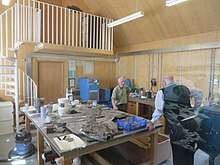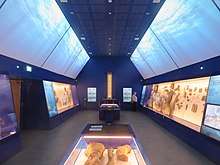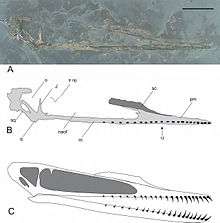Steve Etches


Dr Steve Etches MBE is an English plumber, fossil collector and preparator in Kimmeridge, on the Isle of Purbeck. He was born in 1949 and, from an early age, he began to find, collect and restore the fossils he found on the Jurassic Coast. His collection is now housed in a museum called The Etches Collection which was purpose-built, both to house the collection and to replace the deteriorating local village hall. He has won prizes for his palaeontology and was made a member of the Order of the British Empire by the Queen in 2014. On 24 July 2016, Steve Etches was awarded the degree of Doctor of Science, honoris causa, by the University of Southampton.[1][2][3][4]
Significant finds
Steve Etches has been collecting for over 30 years, and in this time he has amassed an important collection of rare and unique fossils. His first find was a flint fossil sea urchin which he found at age 5. His collection now contains about 2,300 specimens, many of which are scientifically significant.[5]
Ammonite eggs
Whilst cephalopod eggs had previously been described twice within scientific literature,[6][7] the discovery of 8 clusters of eggs in association with perisphinctid ammonite by Steve Etches, Jane Clarke and John Callomon in 2008[8] provides the best preserved example of this rare glimpse into the life cycle of ammonites. The eggs show some phosphatic films suggesting that the eggs were already decaying at their time of burial.

Cuspicephalus
The skull of the pterosaur Cuspicephalus was collected from the Kimmeridge Clay by Steve Etches in December 2009 and then named by Steve Etches and David Martill in 2013. Pterosaurs are considered rare within the Kimmeridge Clay[10] as the clays were deposited a considerable distance from land and so such finds are thought to result from crash landings, possibly as a result of poor weather. Such a landing on water would be likely be fatal to pterosaurs as their thin, hollow bones would be prone to breaking on impact with the sea, as seen in other pterosaur specimens collected by Steve.
Other finds
Other finds by Steve include an exceptionally well-preserved dragonfly wing; the oldest recorded barnacle displaying colour and a new genus of barnacle that has since been found living in the sea around Japan. A Jurassic species of ray, Kimmerobatis etchesi, was named in his honour.[11] These specimens can all be seen in the Etches Collection museum.
Awards
- 1993 – The Palaeontological Association's Award to Amateur Palaeontologists[4]
- 1994 – the R. H. Worth Prize of the Geological Society[4]
- 2005 – the Mary Anning Award of the Palaeontological Association[4]
- 2006 – Halstead medal of the Geologists' Association[4]
- 2014 – Member of the Most Excellent Order of the British Empire (MBE)[3]
- 2017 – Degree of Doctor of Science, honoris causa – University of Southampton[3]
References
- ↑ New museum at Kimmeridge for Etches Collection of fossils, BBC, 21 October 2016
- ↑ Alice Shaw (12 October 2016), "Amateur fossil hunter who spent 30 years amassing 2,000 specimens wins grant to build £5m Jurassic Coast museum", The Daily Telegraph
- 1 2 3 Harriet Sherwood (4 November 2016), "Fossil fever: exploring Dorset's Jurassic Coast with Steve Etches", The Guardian
- 1 2 3 4 5 Ted Nield (9 October 2012), Kimmeridge legend, The Geological Society
- ↑ "Series 1: Episode 12". Hugh's Wild West. Series 1. Episode 12. 2018-03-24. BBC Television. Retrieved 30 March 2018.
- ↑ Müller, A. H. (1969). "Nautiliden-Kiefer (Cephalopoda) aus dem Oberen Muschelkalk des germanischen Triasbeckens". Monatsberichte der Deutschen Akademie der Wissenschaften, Mathematisch-Naturwissenschaftliche Klasse.
- ↑ Lehmann, U (1967). "Ammoniten mit Kieferapparat und Radula aus Lias-Geschieben". Paläontologische Zeitschrift. 41: 38–45.
- ↑ Etches, Clarke and Callomon (October 2008). "Ammonite eggs and ammonitellae from the Kimmeridge Clay Formation (Upper Jurassic) of Dorset, England". Lethaia.
- ↑ Martill, David; Etches, Steve (2013), "A new monofenestratan pterosaur from the Kimmeridge Clay Formation (Kimmeridgian, Upper Jurassic) of Dorset, England" (PDF), Acta Palaeontologica Polonica, 58 (2): 285–294
- ↑ Martill, David; Etches, Steve. "A new monofenestratan pterosaur from the Kimmeridge Clay Formation (Upper Jurassic, Kimmeridgian) of Dorset, England". Acta Palaeontologica Polonica. doi:10.4202/app.2011.0071.
- ↑ Underwood, Charlie J.; Claeson, Kerin M. (2017-07-19). "The Late Jurassic ray Kimmerobatis etchesi gen. et sp. nov. and the Jurassic radiation of the Batoidea". Proceedings of the Geologists' Association. doi:10.1016/j.pgeola.2017.06.009. ISSN 0016-7878. Retrieved 2018-03-30.
External links
- The Etches Collection – official website of the collection and museum